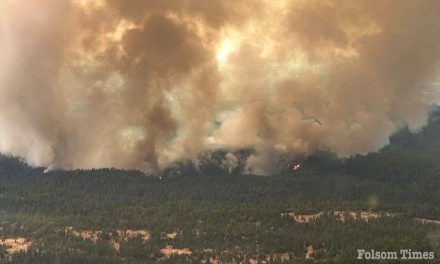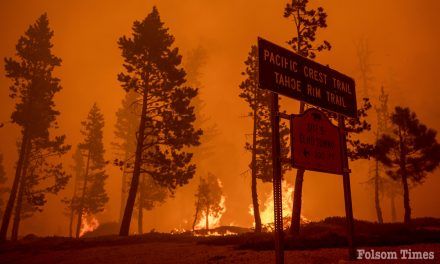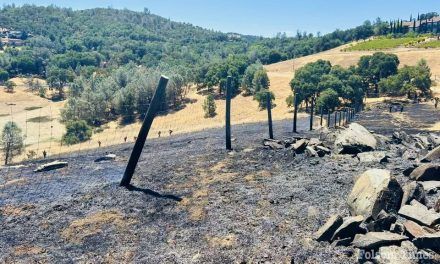It may have gotten off to a mild start but fire season has arrived in the region and local officials are warning residents to not let their guard down just because we had a long-wet winter.
“It will be a year just like all other years, things are going to be readily ignitable,” said Folsom Fire Chief Ken Cusano. “The danger and the potential is out there now, it’s just getting off to a late start across the entire state.”
The record-breaking precipitation that fell this past winter into the Spring months, helped keep vegetation in the area greener much later in the season, which Cusano says can be credited for the slow start to fire season up to this point. However, he warns for residents to not get complacent because fire season is starting a bit later and explained those later rains actually have created even increased dangers ahead.
“While the rains slowed down the arrival of fire season, they also caused an increase in fuel when a fire does get started,” Cusano explained. “We had a lot of late rains, so the vegetation is much taller than normal which increases the potential for much longer flame lengths and faster moving fires. That’s something we are really keeping at the top of mind this year as we respond to these fires.”
While the active season has gotten off to a later start this year, firefighters from Folsom and surrounding agencies have already responded to several vegetation fires in the area. Locally, the largest vegetation fires so far have been a pair of blazes in open areas above Lake Natoma, better known as the Orangevale Bluffs.
The first blaze broke out last Tuesday I the area and burned just under 10 acres. A second blaze in the same area broke out Sunday and threatened area homes once again until it was stopped at approximately four acres by both Folsom and Sacramento Metropolitan Fire crews. While fire officials have not disclosed the exact ignition source of those fires, they are in an area that is known for several homeless encampments, something that poses an added threat this time of year.
“In the coming weeks we will be likely closing down our open spaces within the city limits to the public like we did last year,” said Cusano. Last year, the closure came after the declaration of a fire emergency in the city limits. This year, the city ordinance has been modified to permit the fire chief to declare the closures based on potential fire danger.
“We won’t be closing down the bikes trails or anything like that, those will still be accessible,” explained Cusano. “But we will end up closing down the open spaces around many of them. Nobody really has any business being back in those areas this time of year when fire danger is on the rise.”
The future closures will prohibit all members of the public from trekking into the declared wild land spaces. This means no off-trail hikes will be permitted and it certainly means no camping or residing in those areas will be permitted.
“The vast majority of the fires we have in those types of areas are caused by those who are camping out or living in those areas,” Cusano said. “And when those types of fires start they pose a variety of dangers, not only to property but our firefighters have to be mindful of what types of items can be in an ecampement, from needles to combustibles and even feces, it’s not something we want to send anyone directly into if we can prevent it.”
At this time, Cusano does not have a firm date of when such closures will take place and exactly which areas will be included. The closures will be clearly communicated with residents and it will happen as the area gets closer to Red Flag Warning status, a condition that determined by temperatures and wind combined.
“It’s not temperatures alone that create a Red Flag Warning day, wind is a major factor, “ explained Cusano. “ Winds from the southwest are generally delta-type breeze with a lot of moisture. Winds out of the north are very dry winds and those have the potential to spread fie more rapidly.”
When it comes to being prepared for a vegetation fire in the area, the best advice Cusano wants to give to residents is make sure their properties are fire safe.
“If they haven’t done so already, now is the time property owners need to get busy and make sure they cut down any tall grasses and cut back limbs near their homes,” said Folsom Fire Chief Ken Cusano. “You want to make sure you have everything cut back that will slow own the spread of a fire if and when it should break out.”
While taking the steps to clear dry fuels around the home should be a priority for residents, so should is doing it safely. The last thing you want to do is start a fire while working to prevent one.
“That has been known to happen,” said Cusano. “If you are weed trimming, make sure you are using a nylon type blade and not something metal that can strike a rock and ignite a fire quickly. If you aren’t comfortable doing that type of preparation, there are several companies that will do it for you that you can hire too. It could really be worth it down the road.”
Making sure your home has adequate defensible space
California law requires homeowners to maintain up to 100 feet of defensible space to create a buffer between a building on your property and the grass, trees, shrubs, or any wildland area that surround it.
This space is needed to slow or stop the spread of wildfire and it helps protect your home from catching fire, either from direct flame contact or radiant heat. Defensible space is also important for the protection of the firefighters defending your home. The 100 feet of defensible space is broken down into two zones (if space permits).
Zone 1: First 30 feet
- Remove all dead vegetation. Remove or prune flammable plants and shrubs near windows.
- Remove dead or dry leaves and pine needles from your yard, roof, and rain gutters.
- Keep tree branches at least 10 feet away from your chimney and other trees.
Zone 2: From 30 to 100 feet
- Cut or mow grass down to four inches or shorter.
- Create horizontal spacing between shrubs and trees.
- Create vertical spacing between grass, shrubs, and trees.
Additional suggestions:
- Always have a garden hose connected to each hose bib around the perimeter of your home or business.
- Mow your lawn before 10 a.m. and make sure you are not mowing over rocks or other materials that can create a spark.
- Prepare an emergency kit for your family in case you must evacuate, and include enough items to last for at least 72 hours.
- Know at least two ways out of your neighborhood.
- When it is time to remodel your home, use ignition-resistant materials for the exterior, such as Class-A roofing, cement-fiber or stucco siding, gutter guards, fine-mesh gable vents, fire-rated windows, metal shade structures, and non-wood decking.




